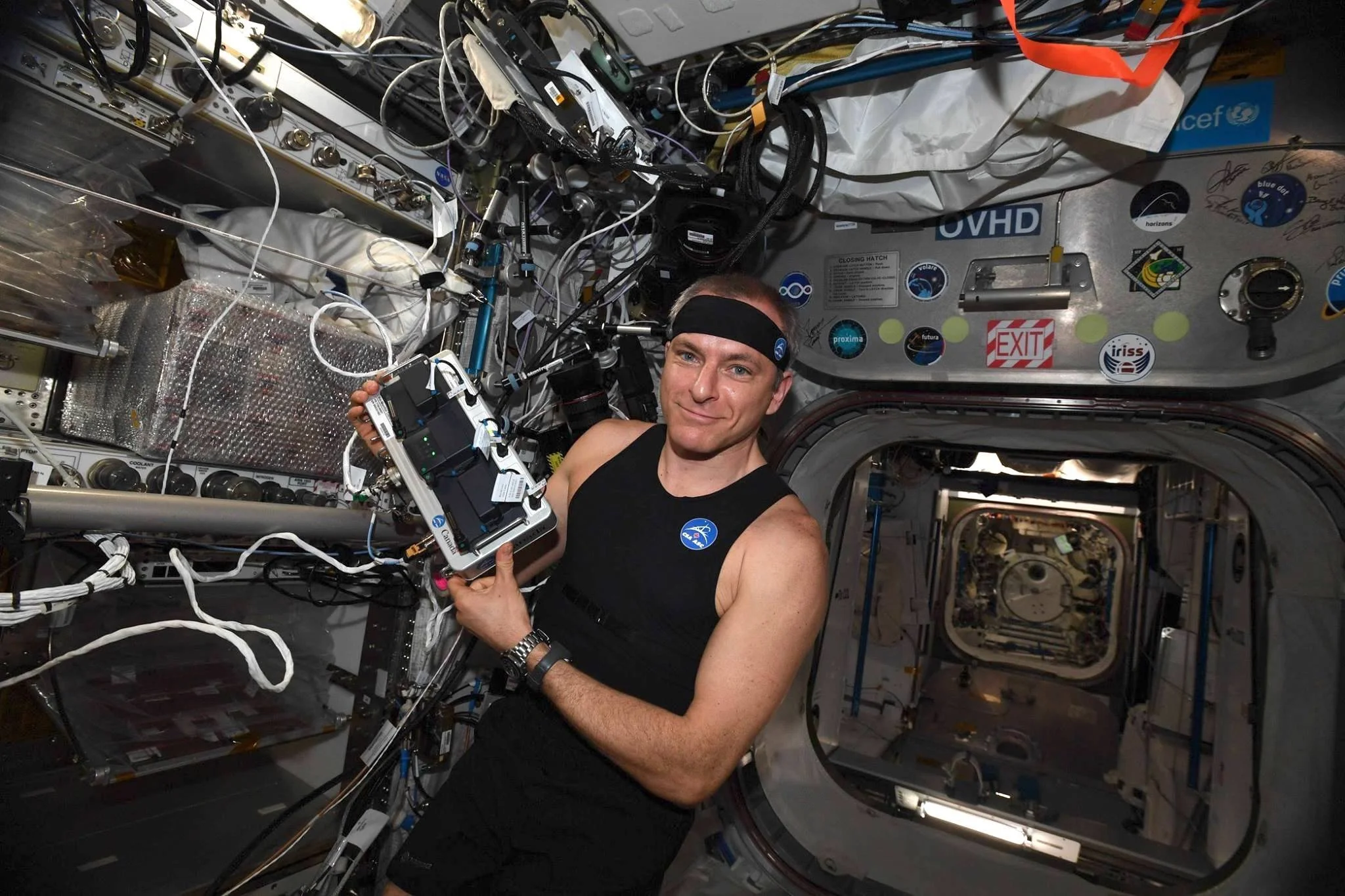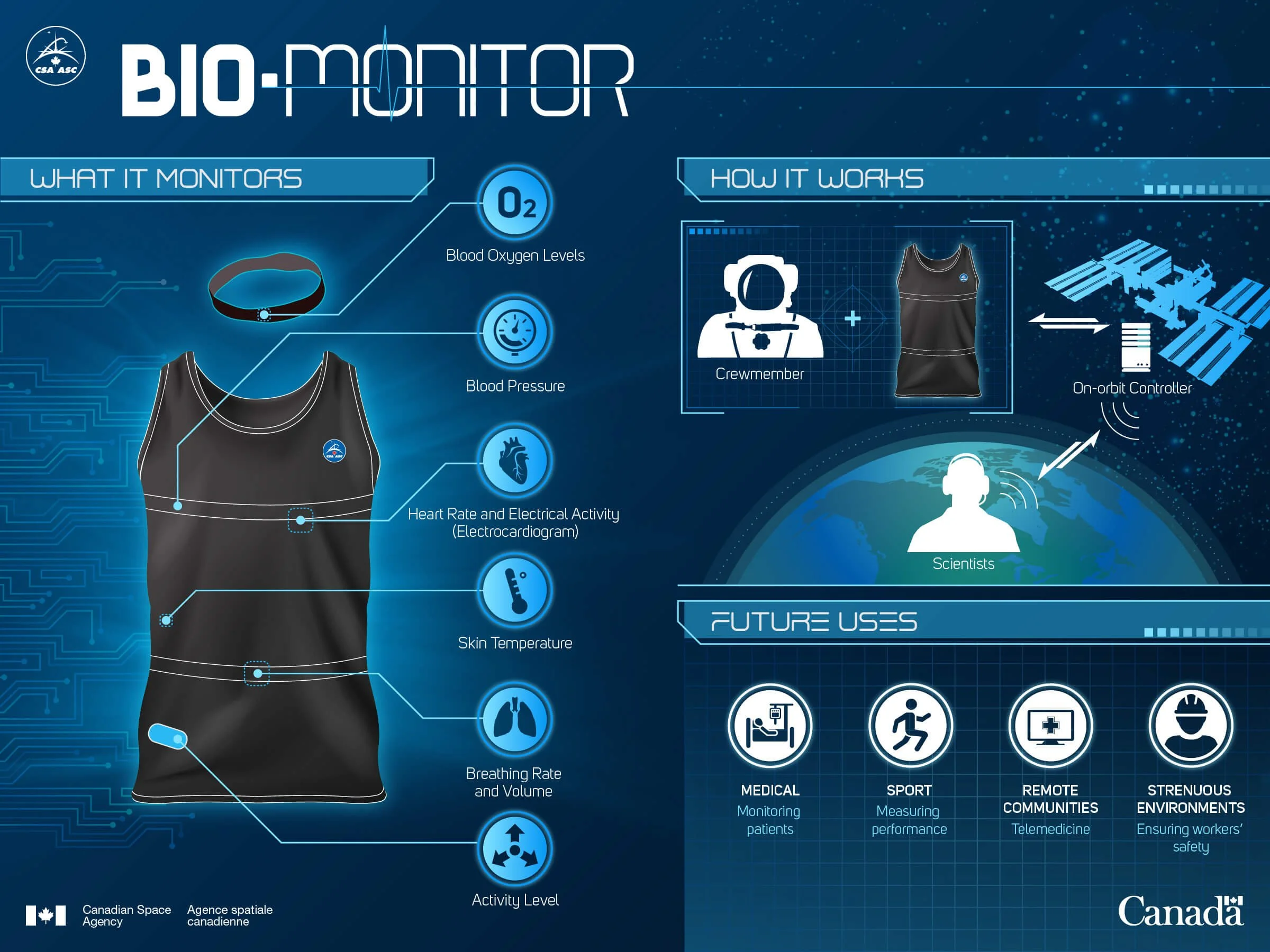Wearables + AI Triage: Continuous Health Monitoring When Staff Are Scarce
Onboard the International Space Station in 2019, Canadian astronaut David Saint-Jacques tested various AI-powered biomedical monitoring garments.
Credit: NASA
Turning sparse med teams into a proactive service with Astroskin-class data and ISS-tested playbooks
In deep space, there is no night shift of extra clinicians. That’s why continuous, multi-parameter monitoring plus AI triage is the most practical way to keep crews healthy without adding people. The template already exists: the Canadian Space Agency’s (CSA) Bio-Monitor (Astroskin) and NASA’s remote-guidance doctrine show how to gather and act on data when staff are few and time is tight.
Astroskin, developed by Quebec-based company Hexoskin in partnership with the CSA, is a smart garment and headband that streams ECG, respiration, pulse-ox, skin temperature and more to an onboard tablet, designed to fit into daily life on the ISS. NASA and CSA have jointly validated it in ground analogues like HERA to raise tech-readiness and to build the decision-support analytics that turn raw vitals into risk flags—heart-rate variability for stress, sleep quality dips that predict fatigue, heat-stress markers during EVA training. It’s not theory; it’s a deployed platform with a public spec and published evaluation goals.
This infographic highlights the advantages of CSA’s Astroskin biomedical monitoring clothing. AI programs that monitor health data onboard a spacecraft in real-time through smart clothing and fabrics suggest that AI technology and wearables can provide practical and immediate benefits to astronauts, rather than depending on distant doctors back on Earth.
Credit: Canadian Space Agency
Combine that stream with imaging on demand. NASA’s Ultrasound-2 remote-guidance methods let non-experts capture diagnostic images that meet clinical standards. Add Tele-SUS protocols, which proved astronauts can self-scan muscle over months with ground guidance, and you get a credible pathway for low-staff triage: AI flags a worrisome vitals trend; crew capture a quick self-ultrasound to check fluid status or musculoskeletal strain; ground reviews asynchronously if bandwidth is tight.
What does AI actually do here? Three modest but powerful things. (1) Quality control: grade signal and image quality in real time, prompting the wearer or scanner to adjust until data are usable. (2) Fusion: combine HRV, sleep, motion and oxygenation to score stress and fatigue and to prioritise checks. (3) Escalation: highlight patterns (e.g., rising respiration with falling SpO₂) that deserve a clinician’s eye. NASA’s HFBP/HRP materials already define the stressors and behavioural-health risks; AI just compresses the time from signal to notice.
The commercial posture that wins treats this as an availability service. Offer the garment kit, secure data pipeline, on-device analytics for privacy, and a playbook for remote triage—plus SOPs for consent and data protection that legal teams can approve. Package updates as certified releases; publish validation deltas (e.g., better artefact rejection, improved sleep-stage classification) with each version. And include an offline mode so crews aren’t stranded by comms outages.
Sceptics will ask about false positives, privacy and operational load. The counter is to show bounded workflows: who gets pinged, how often, and how many taps to acknowledge or escalate. Build in human-in-the-loop review at sensible thresholds. Emphasise on-device processing and opt-in sharing to reduce privacy concerns. Most importantly, price by time saved (fewer unscheduled medical consults; fewer unnecessary countermeasures) rather than abstract AI value.
The bottom line is that wearables plus AI can convert a thin medical staff into a proactive service, catching issues early and prioritising scarce attention. Astroskin and ISS ultrasound have already proven the data can be captured; AI’s job is to make that data actionable without adding to workload.

